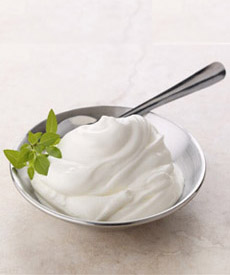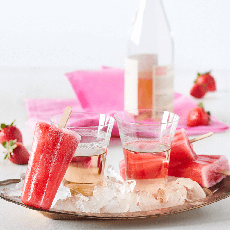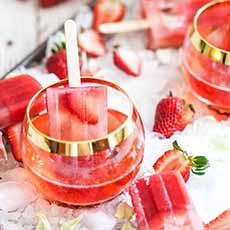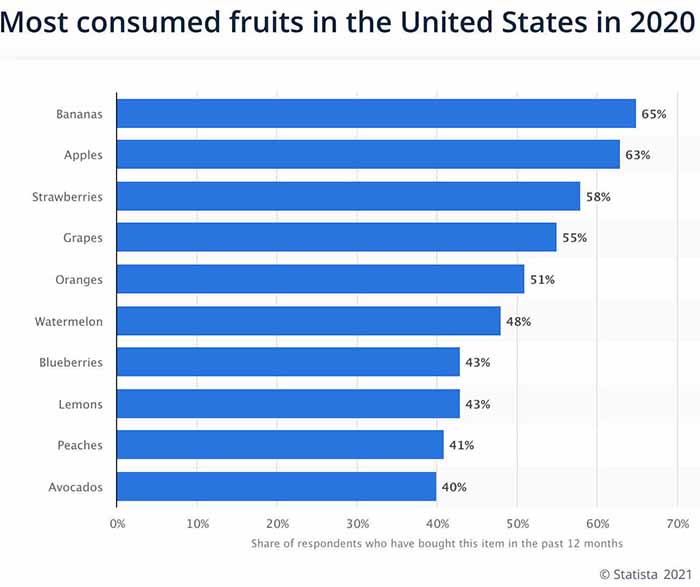|
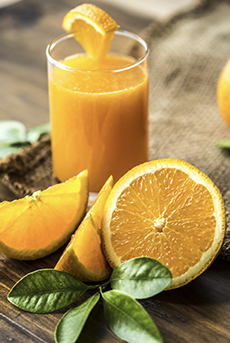
[1] A classic part of many American breakfasts: a glass of orange juice (photo courtesy Sting | Wikipedia).
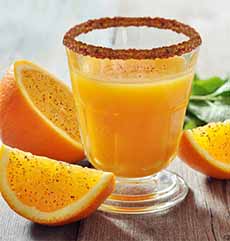
[2] Celebrate the day with something special: a rim of Tajin seasoning on your glass of orange juice (photo © Tajin).
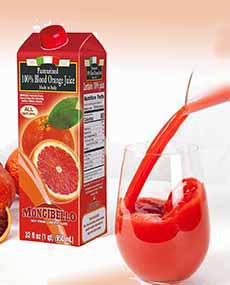
[3] A glass of blood orange juice is a special treat (photo © Mongibello Juice).
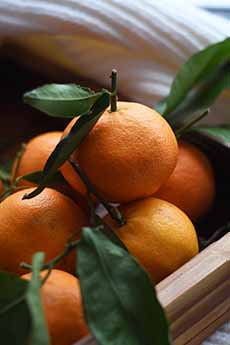
[4] Squeeze your own (photo © Marina Raspopova | Unsplash)./span>
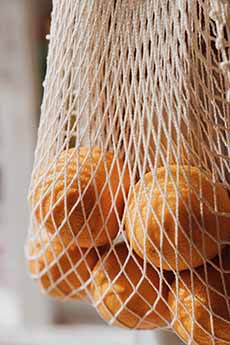
[5] Squeeze your own, part 2 (photo © Cotton Bro | Pexels).
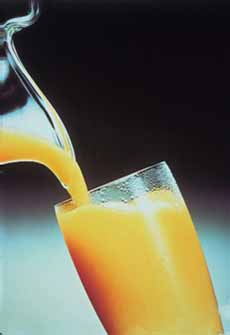
[6] In the 1950s through the 1980s, much orange juice drunk at home was frozen concentrate, mixed with water in a pitcher (photo © Florida Citrus).
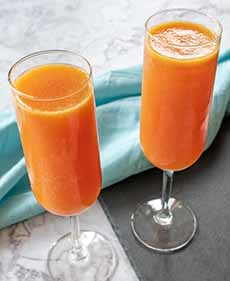
[7] Bottoms up: The Mimosa is a blend of Prosecco and orange juice. If you prefer vodka with your orange juice, that’s a Screwdriver (photo © Mongibello | Facebook)
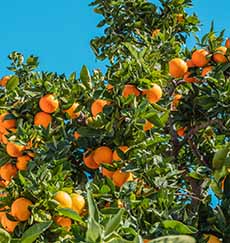
[8] Growing in a grove (photo © Philippe Gauthier | Unsplash).
|
|
May 4th is National Orange Juice Day, a holiday sponsored by the Florida Department of Citrus. Florida processes more orange juice than any other state (much of it becomes frozen juice concentrate).
Florida’s crops are mostly juice oranges, while California produces the majority of table oranges as well as orange varieties for juicing.
Brazil is the leading global orange juice producer by far, with a production volume of more than three times the second-place producer*, the U.S.
Brazil 1,022 million metric tons
U.S. 297 million metric tons
Mexico 90 million metric tons
HOW TO CELEBRATE NATIONAL ORANGE JUICE DAY
Start by checking out our 10 Uses For Orange Juice, beyond drinking a glass of it.
We’re starting our celebration with:
A big glass of blood orange juice with breakfast (photo #3).
A dinner that includes a blood orange cocktail, roast chicken basted with blood orange juice, and a vinaigrette with blood orange juice.
A blood orange granita for dessert.
CITRUS BEYOND ORANGES
Lemons, oranges, limes, grapefruit, tangerines, and pomelos are just a few of the juicy citrus fruits grown in Florida.
Citrus contains the anti-carcinogen antioxidants known as flavonoids.
Citrus also is packed with fiber and vitamin C, and lesser amounts of calcium, potassium, and vitamin A.
MORE CITRUS HOLIDAYS TO CELEBRATE
January is National Citrus Month
National Clementine Day is February 15
National Mandarin Orange Day is March 20
National Oranges and Lemons Day is March 31
National Orange Juice Day is May 4
National Orange Blossom Day is June 27
National Grapefruit Month is February
National Lemon Juice Day is August 29
National Lime Day is September 26
You may come across other holidays with a citrus title that doesn’t honor the fruit.
For example, March 24th is National Orange Day at Syracuse University, when students and alumni honor the university’s color, orange.
THE HISTORY OF ORANGES
There are three types of oranges: sweet oranges (Citrus x sinensis), bitter oranges (Citrus x aurantium), and mandarins (Citrus reticulata)—here’s the difference between mandarins and oranges.
Oranges are members of the Rutaceae family, which includes the citrus genus and many species within the genus (grapefruits, lemons, limes, oranges, pomelos, etc.). There are some 1,600 subspecies.
The oranges we mostly consume are sweet oranges (bitter oranges are used for marmalade and some other culinary purposes).
The sweet orange is a hybrid between the pomelo (Citrus maxima) and the mandarin. Sweet oranges are about 70% of the global citrus industry.
Wild oranges originated in the region that is now southern China and northern India. They have been cultivated for at least 7,000 years in India, and in China for some 4,500 years.
They were bitter and originally used for medicinal purposes, with sweet varieties developed after centuries of breeding.
It is believed that traders from the Persian Empire brought oranges from India and Sri Lanka to the Roman Empire, as early as 100 B.C.E. Oranges then spread by multinational trading ships and caravans.
The Romans, known for bringing their agricultural products to their conquered territories, spread orange trees across the Mediterranean. From Libya, groves spread to Morocco and Spain.
Portuguese traders established trade routes around Africa’s Cape of Good Hope to Asia. Their travels introduced oranges around the globe.
Italian traders traded oranges in the Mediterranean region in the 1400s.
Spanish colonists brought oranges to the New World by the 1500s. Ponce de Leon is alleged to have brought the first orange trees (bitter oranges) to Florida in the early 1500s.
By 1579, the city of St. Augustine, Florida had its first citrus groves.
The French brought oranges to what is now Louisiana. From New Orleans, those seeds were brought to Florida about 1872, and many orange groves were established by grafting the sweet orange onto sour orange rootstocks [source].
The Spanish brought oranges to South America and to their missions in Arizona and California. Arizona received the orange tree with the founding of missions between 1707 and 1710 [ibid].
In California, the orange was brought to San Diego by those who built the first mission there, in 1769. An orchard was planted at the San Gabriel Mission around 1804. A commercial orchard was established in 1841 on a site that is now a part of Los Angeles, by William Wolfskill [ibid].
In 1781, a surgeon and naturalist on the ship Discovery, collected orange seeds in South Africa, grew seedlings on board, and presented them to tribal chiefs in the Hawaiian Islands on arrival in 1792. (alas, the crop had to be abandoned after a Mediterranean fruit fly infestation).
DEVELOPING THE MODERN ORANGE
By the 11th century, using seeds of Persian oranges, Spain and Morocco began to produce improved orange varieties.
One well-known variety is the Seville orange from Spain, a bitter orange used for marmalade and liqueurs.
Soon, oranges were grown on Cananeia, an island off São Paulo in Brazil.
The orange became a popular and healthy† fruit globally.
Today, oranges are the fifth most-purchased fruit in the U.S., following bananas, apples, strawberries, and grapes [source].
Prior to 1920, the orange was mainly served as a dessert fruit. The per-capita consumption increased with:
The spread of orange juice as a beverage.
The growing appreciation of the dietary value of citrus fruits [source].
The bulk of U.S. orange crop consists of three main varieties: the Washington Navel, the Valencia, and the Hamlin. Other varieties, including the blood and bergamot oranges, are grown in smaller amounts.
The Washington Navel orange has a thick, easy-to-peel rind and is easy to segment, making it one of the most popular eating oranges. It is not used for juicing, as its higher limonene content adds bitterness.
The Valencia orange is smaller and juicier than Navels, with a thinner rind and few seeds. It is popular for juicing. It is the most popular juicing variety grown in California.
The Hamlin is similar to the Valencia, but with a lighter color fruit and juice. Seedless, it is popular for juicing. It is the most popular variety grown in Florida.
MODERN ORANGE JUICE
Prior to World War II, most Americans drank canned orange juice. During World War II, the federal government and the Florida Department of Citrus worked with a group of scientists to develop a superior-tasting product.
The result, frozen concentrated orange juice, was introduced in 1948. A small tube, easy to store in the freezer, was mixed at home with water. The juice was affordable, tasty, convenient, and high in vitamin C.
By the 1980s, food scientists had developed a fresher-tasting refrigerated juice known as reconstituted ready-to-serve juice. The next improvement, in the 1990s, “not from concentrate” (NFC) refrigerated juice, remains the standard today.
|











